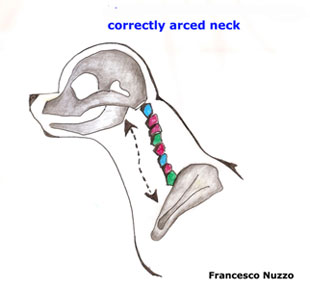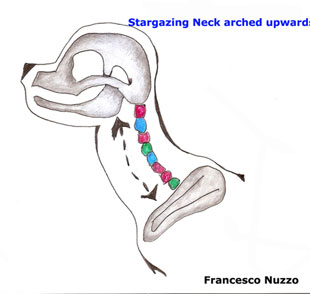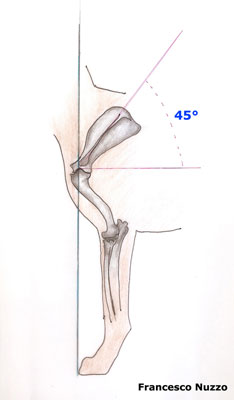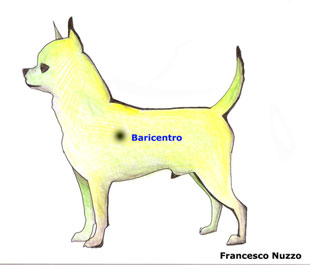- WELCOME
- HOME
- ABOUT US
- CHAMPIONS
-
VERY IMPORTANT DOG
- Ch. South Fork's Jelly Bean
- Ch. South Fork's The Beat Goes On
- Ch. Yo Te Quiero Di Rio Galeria
- Ch. South Fork' Jazz It Up
- Ch. Tocai Di Rio Galeria
- Ch. South Fork's Contradiction
- Ch. South Fork's Music Man
- Ch. El Nino Di Rio Galeria
- Ch. Xsaraja Di Rio Galeria
- Ch. De Gozette Lotus
- Ch. Eldorado Di Rio Galeria
- Ch. Jaqueline Di Rio Galeria
- Ch. Dacarella's Hellf Angel
- SHOW RESULTS
- PUPPIES
- INFO CHIHUAHUA
- CONTACTS
- TOOLS
Dog Expertise
By Paolo Tartaro andFrancesco di Paola Nuzzo
- Source: Magazine All About Chihuahua n° 3
| We are at the third part of the description of our breed, we now look to the specific regions of the neck, withers and shoulder. As always we will follow the principles of the Study of Dog Conformation (cinognostica) to simplify and to be clear and certain to describe beauty according to the standard, using the the rules of anatomy, mechanics, functionality and harmony, excluding the subjective perception of beauty. Therefore, as in the previous issue our writing will be technical , not some kind of story, and based on our experience on the living, through our knowledge and on information that gathered from various sources. In the two previous issues of All About Chihuahua we described the head and its two regions: cranial and facial, expression, eyes, ears and teeth, dwelling on the faults related to lack or excess of type. In the head we find most of the type characters but As we will see the rest of the body has also some basic characters of the type. |
|
 |
NECK The neck is the region located in front of the trunk intended to carry the head. It consists of a section of the spine, the anatomical ground of the neck has seven cervical vertebrae and numerous and powerful muscles of the region. The first cervical vertebra is called Atlas, is linked to the head and allows water to move vertically, while the second, called the axis, allows the head to rotate. This area is very important to the balance. We will explore the neck, considering, height, tilt, volume and profile, and the relationship of the neck with the head, shoulder and withers, and the key role of the neck in movement. The neck has a shape of a truncated cone whose base is joined to the body and at the other end to the head. The neck of a Chihuahua should be of medium length and somewhat cylindrical. The correct development in the longitudinal direction allows, during movement, a wide projection of the thoracic limbs forward, thanks to the greater contraction of the locomotor muscles of the forelimbs, being these longer, in relation to the length of the region. The correct length of the neck, is always associated with good strength, a sign of distinction and elegance. If a neck is too long, in Chihuahua, is often associated with a too slender body, with a long spine, weak shoulders, underdeveloped chest, long and thin limbs, the so-called "deer type". This type of fault is nowadays fortunately less frequent, whereas the opposite fault is more common. A short neck gives you the idea of a head lying directly on the trunk, this effect is stronger in long-coat Chihuhua because of the greater amount of fur that hides the true size and outline of the neck. According to Solaro, a neck of reduced length, reduces the forward movement of the thoracic limbs, and often has a slightly sloping shoulder, this lack is offset by a very oblique humerus. In this case observing a Chihuahua in still position, we see the forequarters under him, in addition the neck does not blend harmoniously between the shoulders. The harmonious blend of neck and trunk is absolute quality. This smooth balance is not only due to length of the neck, but also to the proper tilt of the shoulder blades and to a well marked withers. The nape should be properly outlined. And that is a sign of distinction and elegance. The head and the neck ensemble is called head neck balancing. The head neck balancing also acts as a tensor of the lumbar spine column, acting on the driving forces generated by the pelvic limb, the withers, the back and the lumbar to the anticlinal vertebra support the forward movement of the trunk. Moreover, a correct length of the neck is essential to move the CG (centre of gravity) forward, to make the transition from static balance to movement balance easier than that of a neck with a limited length. |
 |
|
| Centre of gravity means the meeting point of the of gravity forces , every body has such a point and it is also called a body's gravity centre, because every body is attracted vertically into the centre of the earth by this force. In dogs, the CG is located in the cardiac region, with slight variations in positions from breed to breed, according to their morphology. Continuing to describe the neck region of Chihuahua we can say that its dorsal outline is slightly curved and this is most marked at mid-length and is even more noticeable with the dog is a alert state, strictly its upper profile is arched toward the back or neck with noble and elegant head bearing. This kind of neck profile is considered the most efficient in the Study of Dog Conformation (cinognostica) in almost all breeds and it is certainly to be found in our breed. In our experience, and according to some British authors, if the dorsal ouline of the neck is opposite the above mentioned, that is concave, we have a head bearing upwards, certainly attractive to watch, called "stargazing", but this causes the shift of the gravity centre backwards causing a greater effort in the hindquarters, and also causes the forequarters to be "thrown up" generating a sort of incorrect stepping gait and less speed, certainly not typical of the breed standard. The skin of the neck should be supple and taut. The lower neck and throat must be absolutely dry with no loose skin, and with no wrinkles,folds or dewlap. The dewlap, which is two skin folds originating from the lower jaw that extend along the ventral margin of the neck, is a fault for the Chihuahua and also for many other breeds, while is required by the standard of other breeds. The coat in the neck area should be a bit longer (ruff) than the rest of the body to make it look bigger and stronger than it actually is, especially in males. |
|
SHOULDER Flex - brought back, The requirements of morphological and spatial direction of the scapulae are important indicators for the functional morphology. The low mobility is an absolute failure for all breeds, otherwise mobility of the shoulder is the absolute value because they ensure greater ease in the movements allowed by the above five. |
 |
 |
WITHERS In future issues we will continue the analysis of the trunk. |
back to articles page
diriogaleria@chihuahua.it | musicvelvet@chihuahua.it
Words and images ©2011 Di Rio Galeria & Music Velvet Kennels - All rights reserved | Web site by TwentyfourCatsandDogs ©
